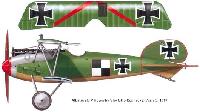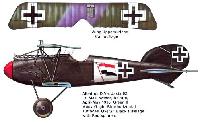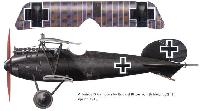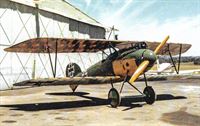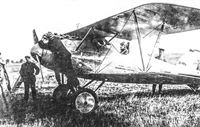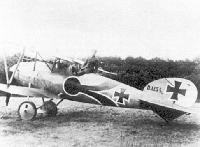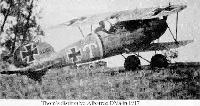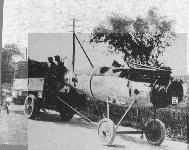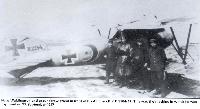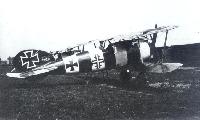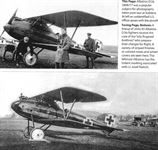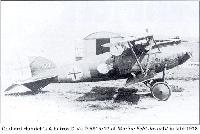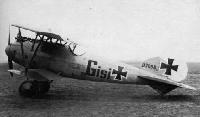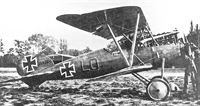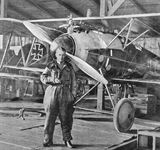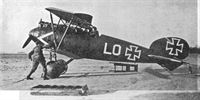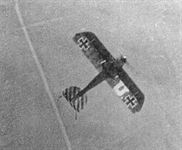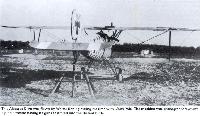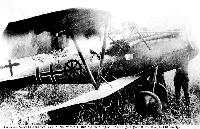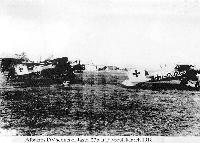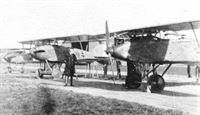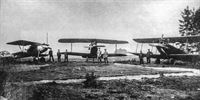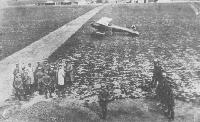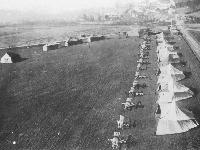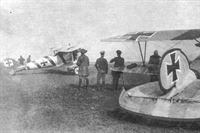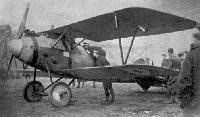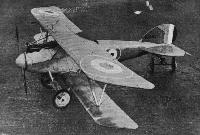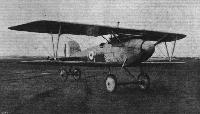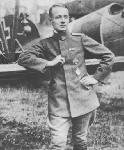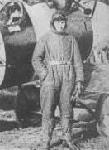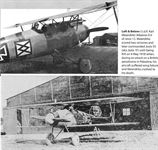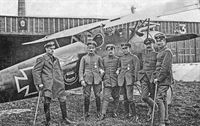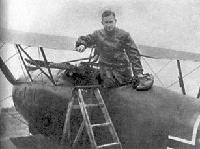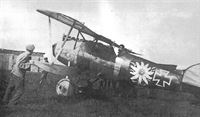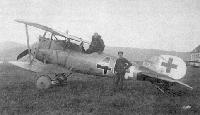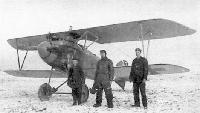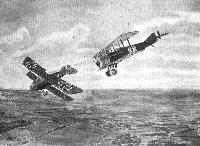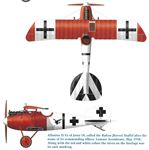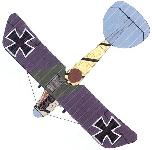
Описание
Страна: Германия
Год: 1917
Истребитель
Варианты
- Albatros - D.III - 1916 - Германия
- Albatros - C.XIII - 1917 - Германия
- Albatros - D.V/D.Va - 1917 - Германия
- Albatros - Dr.I - 1917 - Германия
- В.Кондратьев Самолеты первой мировой войны
- O.Thetford, P.Gray German Aircraft of the First World War (Putnam)
- W.Green, G.Swanborough The Complete Book of Fighters
- J.Herris Albatros Aircraft of WWI. Vol.4: Fighters (A Centennial Perspective on Great War Airplanes 27)
-
Сайт - Pilots-and-planes /WWW/
Albatros D.V 1033/17 & Albatros D.V 4693/17. Both machines were finished in this scheme. Victories 58 and 59 were obtained in 4693/17, and on July 6, 1917, Richthofen was shot down and seriously wounded in 1033/17.
-
В.Кондратьев - Самолеты первой мировой войны
Альбатрос D.V, пилот - обер-лейтенант Э. фон Достлер, июль 1917г.
-
Сайт - Pilots-and-planes /WWW/
Albatros D.V D.1148/17 flown by Ltn Hans Adams, Jasta 6, summer 1917.
-
J.Herris - Albatros Aircraft of WWI. Volume 4: Fighters /Centennial Perspective/ (27)
Albatros D.V D.1177/17 flown by Rittmeister Manfred Freiherr von Richthofen of Jasta 11 in June 1917. Richthofen was the Red Baron, the leading ace of the war with 80 victories. The mauve and dark green on the wings shows through the thin coat of red paint.
-
Сайт - Pilots-and-planes /WWW/
Albatros D.V 1177/17 Victories 54, 55, 56 and 57 were obtained in this machine.
-
Сайт - Pilots-and-planes /WWW/
Albatros D.V (D.1162/17) Jasta 4, 1917.
-
J.Herris - Albatros Aircraft of WWI. Volume 4: Fighters /Centennial Perspective/ (27)
Albatros D.V D.2006/17 flown by Lt.d.R. Bernhard Kilian of Jasta 21. Kilian was killed in a flying accident on 9 December 1917 at Pauvres Aerodrome.
-
J.Herris - Albatros Aircraft of WWI. Volume 4: Fighters /Centennial Perspective/ (27)
Albatros D.V D.2021/17 flown by Lt. Heinrich Vollertsen of Jasta 36, Autumn 1917. He was KIA on 3 Sep. 1917, perhaps by AA fire.
-
Сайт - Pilots-and-planes /WWW/
Albatros D.V D.2030/17, Jasta 22, Lt. Alfred Lenz, Vivaise, August 1917. Green & Mauve/Light Blue horizontal surfaces. Overall Green fuselage.
-
Сайт - Pilots-and-planes /WWW/
Albatros D.V 2059/17. Victories 62 and 63 were obtained in this machine.
-
Сайт - Pilots-and-planes /WWW/
Albatros D.V D.2092/17 flown by Ltn Walter Boning, Staffelfuhrer of Jasta 76b, early 1918
-
M.Schmeelke - Ballon Hoch /Centennial Perspective/ (91)
Albatros D.V 2194/17, Hptm. Adolf Ritter von Tutschek, Jasta 12/JG 2, 27 total victories, 3 balloons
-
Сайт - Pilots-and-planes /WWW/
Albatros D.V D.2214/17 flown by Ltn Heinrich Kroll, Jasta 24, summer 1917
-
J.Herris - Albatros Aircraft of WWI. Volume 4: Fighters /Centennial Perspective/ (27)
Albatros D.V D.2236/17 LULU flown by Vzfw. Ludwig Weber of Jasta 3. Weber had a flare gun mounted to fire downward and to the rear. Weber scored two victories and, although WIA, survived the war.
-
Сайт - Pilots-and-planes /WWW/
Albatros D.V 2236/17 flown by Leutnant Ludwig Weber of Jasta 3
-
Сайт - Pilots-and-planes /WWW/
Albatros D.V 2263/17 flown by Otto Kissenberth, Jasta 23b, summer 1917
-
Сайт - Pilots-and-planes /WWW/
Albatros flown by Otto Kissenberth, Jasta 16b, mid-1917
-
Сайт - Pilots-and-planes /WWW/
Albatros D.V 2284/17 flown by Ltn Hans Waldhausen, Jasta 37, late summer 1917
-
Сайт - Pilots-and-planes /WWW/
Albatros D.V 2299/17 flown by Oblt Bruno Loerzer, leader of Jasta 26, autumn 1917
-
В.Кондратьев - Самолеты первой мировой войны
"Альбатрос" D.V из 26-й истребительной эскадрильи (Jasta 26) германских ВВС, осень 1917г.
-
Сайт - Pilots-and-planes /WWW/
Albatros D.V 2359/17 flown by Lt d Res Otto Hohmuth. Captured March 6, 1918.
-
J.Herris - Albatros Aircraft of WWI. Volume 4: Fighters /Centennial Perspective/ (27)
Albatros D.V D.4476/17 flown by Lt. Ernst Udet of Jasta 37, Phalempin Aerodrome, September 1917. During this time the Jasta 37 colors were diagonal black & white stripes on the horizontal tail surfaces. "LO" on the fuselage was Udet's personal marking in honor of his fiance Eleonore "Lo" Zink.
-
Сайт - Pilots-and-planes /WWW/
Albatros D.V (D.4594/17) Jasta 18, 1918.
-
J.Herris - Albatros Aircraft of WWI. Volume 4: Fighters /Centennial Perspective/ (27)
Albatros D.V D.4665/17 of Kest la at Mannheim Aerodrome. It was part of the last batch of D.V fighters ordered in July 1917 and appears to have diagonal black stripes under its lower wings.
-
J.Herris - Albatros Aircraft of WWI. Volume 4: Fighters /Centennial Perspective/ (27)
Albatros D.Va D.5253/17 flown by Lt. Max Sadowsky of Jasta 14, November 1917. On November 13th he was brought down by AA fire and this aircraft was exhibited in the Agricultural Hall in London.
-
Сайт - Pilots-and-planes /WWW/
Albatros D.V 5284/17 flown by Vfw Josef Mai, Jasta 5, late 1917
-
J.Herris - Albatros Aircraft of WWI. Volume 4: Fighters /Centennial Perspective/ (27)
Albatros D.Va D.5385/17, perhaps of Jasta 77b. This batch of fighters had the 5-color printed camouflage fabric on the wings and elevators unusually applied span-wise. The "Bavarian blue" tail was the Jasta 77b colors; rudder and elevators were white. The "Moritz" character was from the popular "Max and Moritz" stories.
-
J.Herris - Albatros Aircraft of WWI. Volume 4: Fighters /Centennial Perspective/ (27)
Albatros D.Va D.5773/17, pilot and unit unknown.
-
Сайт - Pilots-and-planes /WWW/
Albatros D.V D.5815/17 flown by Gerhard Hubrich, Seefrosta 1, summer 1918
-
Сайт - Pilots-and-planes /WWW/
Albatros D.Va(OAW) (D.6633/17) Jasta 78b, 1918
-
J.Herris - Albatros Aircraft of WWI. Volume 4: Fighters /Centennial Perspective/ (27)
Albatros D.Va D.7005/17. The crest of the city of Hamburg was painted on the side. The pilot was Lt. Bieber of a Seefrontstaffel, hence the markings are thought to be yellow.
-
J.Herris - Albatros Aircraft of WWI. Volume 4: Fighters /Centennial Perspective/ (27)
Albatros D.Va D.7352/17 flown by Lt. Lehmann of Jasta 59, September 1918. Lehmann scored one victory.
-
J.Herris - Albatros Aircraft of WWI. Volume 4: Fighters /Centennial Perspective/ (27)
Albatros D.Va D.7416/17 flown by Hptm. Franz Walz of Fl.Abt. 304b, Palestine, Summer 1918. The fuselage stripe was continued onto the spinner. Two airfoil radiators were fitted.
-
J.Herris - Albatros Aircraft of WWI. Volume 4: Fighters /Centennial Perspective/ (27)
Albatros D.Va of Jasta 15, Balatre Aerodrome, May 1918. Formerly the aircraft of Oblt. Harald Auffarth, it was taken over by Oblt. Wilhelm Turck when Auffarth was transferred to Jasta 29.
-
J.Herris - Albatros Aircraft of WWI. Volume 4: Fighters /Centennial Perspective/ (27)
Albatros D.V flown by Lt. Josef Veltjens of Jasta 18, early 1918. The arrow was Veltjens' personal insignia. He survived the war with 35 victories and was awarded the Pour le Merite.
-
J.Herris - Albatros Aircraft of WWI. Volume 4: Fighters /Centennial Perspective/ (27)
Albatros D.Va flown by Lt. Werner Niethammer of Jasta 13, Summer 1918. Niethammer scored 6 victories and survived the war.
-
J.Herris - Albatros Aircraft of WWI. Volume 4: Fighters /Centennial Perspective/ (27)
Albatros D.Va flown by Lt. Helmut Dilthey, commander of Jasta 40, June/July 1918. Dilthey scored 7 victories and was KIA on 9 July 1918 over Lille.
-
J.Herris - Albatros Aircraft of WWI. Volume 4: Fighters /Centennial Perspective/ (27)
Albatros D.V flown by Lt. Heinrich Georg Geigl of Jasta 16b, March 1918. Geigl was KIA when he collided with a Sopwith Camel, which was credited as his 13th victory.
-
J.Herris - Albatros Aircraft of WWI. Volume 4: Fighters /Centennial Perspective/ (27)
Albatros D.V flown by Off.Stv. Adolf Schreder of Jasta 17. Schreder shot down an SE.5a before being KIA on 17 March 1918.
-
J.Herris - Albatros Aircraft of WWI. Volume 4: Fighters /Centennial Perspective/ (27)
Albatros D.V flown by Vzfw. Franz Schmidt of Jasta 32b. He later rose to Ltn.d.R. and scored one victory, downing a Spad on 30 Sep. 1917. The black tail was the Jasta marking.
-
J.Herris - Albatros Aircraft of WWI. Volume 4: Fighters /Centennial Perspective/ (27)
Albatros D.V of Jasta 55 (aka Jasta 1F), Djenin Aerodrome, Palestine, Spring 1918. Two airfoil radiators were fitted. The green/mauve wing camouflage is speculative.
-
J.Herris - Albatros Aircraft of WWI. Volume 4: Fighters /Centennial Perspective/ (27)
Albatros D.V of Jasta 32b.
-
J.Herris - Albatros Aircraft of WWI. Volume 4: Fighters /Centennial Perspective/ (27)
Albatros D.Va flown by an unknown pilot of Jasta 58, Summer 1918.
-
J.Herris - Albatros Aircraft of WWI. Volume 4: Fighters /Centennial Perspective/ (27)
Albatros D.Va flown by Oblt. Rudolf von Esebeck of Jasta 17, Wasquehal Aerodrome, Autumn 1917, Von Esebeck scored one victory before being KIA on 27 May 1918.
-
J.Herris - Albatros Aircraft of WWI. Volume 4: Fighters /Centennial Perspective/ (27)
Albatros D.V flown by Vzfw. Manfred Stimmel of Jasta 32b, July 1917. Stimmel was shot down and made POW on 6 July 1917 by Lt. Armand de Turenne of N12 and Capt. Georges Matton, N48.
-
M.Schmeelke - Ballon Hoch /Centennial Perspective/ (91)
Albatros D.V Mops, Offz. Stv. Julius Buckler, Jasta 17, 36 total victories, 7 balloons
-
J.Herris - Albatros Aircraft of WWI. Volume 4: Fighters /Centennial Perspective/ (27)
Albatros D.V flown by Lt. Karl Meierdirks of Jasta 12. Meierdirks scored two victories and later commanded Jasta 55 until being KIA on 4 May 1918 over Jericho.
-
J.Herris - Albatros Aircraft of WWI. Volume 4: Fighters /Centennial Perspective/ (27)
Albatros D.Va flown by Lt. Alfred Trager of Jasta 17, Winter 1917/1918.
-
J.Herris - Albatros Aircraft of WWI. Volume 4: Fighters /Centennial Perspective/ (27)
Albatros D.Va flown by Lt. Otto Fuchs of Jasta 77b. Fuchs is German for fox, and his personal insignia was a fox chasing a Gallic rooster. Fuchs scored three victories and survived the war.
-
J.Herris - Albatros Aircraft of WWI. Volume 4: Fighters /Centennial Perspective/ (27)
Albatros D.Va(OAW) flown by Karl Kallmunzer of Jasta 78b with white stars painted over the black portion of the fuselage.
-
J.Herris - Albatros Aircraft of WWI. Volume 4: Fighters /Centennial Perspective/ (27)
Albatros D.V flown by an unknown pilot of Jasta 36, Autumn 1917.
-
J.Herris - Albatros Aircraft of WWI. Volume 4: Fighters /Centennial Perspective/ (27)
Albatros D.V flown by Lt.d.R. Hans Bohning of Jasta 36, Autumn 1917. Bohning scored 17 victories and ended the war commanding Jasta 32b.
-
J.Herris - Albatros Aircraft of WWI. Volume 4: Fighters /Centennial Perspective/ (27)
Albatros D.V flown by Lt.d.R. Hans Bohning of Jasta 76b at Habshiem Aerodrome, Winter 1917/1918. It is not known if this is the machine Bohning flew in Jasta 36. As of 2016 the reproduction D.V at Old Rhinebeck Aerodrome wore this scheme.
-
J.Herris - Albatros Aircraft of WWI. Volume 4: Fighters /Centennial Perspective/ (27)
Albatros D.V flown by Lt. Wolf of Jasta 5, July 1917, who scored two victories.
-
W.Green, G.Swanborough - The Complete Book of Fighters
An Albatros D V of Jasta 5 with a Bavarian Lion motif
-
W.Green, G.Swanborough - The Complete Book of Fighters
A D V of Jasta 5's Jastafuhrer, Lt Wilhelm Lehmann.
-
J.Herris - Albatros Aircraft of WWI. Volume 4: Fighters /Centennial Perspective/ (27)
Albatros D.V flown by Lt. Paul Baumer of Jasta 5, Boistrancourt Aerodrome, January 1918. Baumer scored 43 victories, was awarded the Pour le Merite, and survived the war.
-
Сайт - Pilots-and-planes /WWW/
Albatros D.V flown by Uffz Paul Baumer, Jasta 5, summer 1917.
-
J.Herris - Development of German Warplanes in WWI /Centennial Perspective/ (1)
Albatros D.V flown by Lt Alfred Trager while serving with Jasta 17. Trager's personal marking was the sun painted on the fuselage, and he called this airplane Sonnenvogel (Sun Bird).
-
J.Herris - Albatros Aircraft of WWI. Volume 4: Fighters /Centennial Perspective/ (27)
Albatros D.V flown by Lt. Josef Jacobs of Jasta 7. The upper wing carried two smaller national insignia in addition to the normal insignia. This aircraft was wrecked in a collision on 21 August 1917.
-
Сайт - Pilots-and-planes /WWW/
Albatros D.V flown by Ltn Josef Jacobs, Jasta 7, 1917.
-
J.Herris - Albatros Aircraft of WWI. Volume 4: Fighters /Centennial Perspective/ (27)
Albatros D.Va of Jasta 18, called the Raben (Raven) Staffel after the name of its commanding officer. Lomme Aerodrome, May 1918. Along with the red and white colors the raven on the fuselage was its unit marking.
-
В.Обухович, А.Никифоров - Самолеты Первой Мировой войны
Альбатрос D V
-
M.Schmeelke - Ballon Hoch /Centennial Perspective/ (91)
Albatros D.V, Lt. Heinrich Gontermann, Jasta 15, 39 total victories, 17 balloons
-
Сайт - Pilots-and-planes /WWW/
Albatros D.V flown by Lt. Heinrich Gontermann of Jasta 15
-
Сайт - Pilots-and-planes /WWW/
Albatros D.V flown by Ltn Aloys Heldmann, Jasta 10, late 1917
-
Сайт - Pilots-and-planes /WWW/
Albatros D.V flown by Vfw Otto Konnecke, Jasta 5, 1917
-
Сайт - Pilots-and-planes /WWW/
Albatros D.V flown by Ltn Kurt Monnington, Jasta 15, 1917
-
Сайт - Pilots-and-planes /WWW/
Albatros D.V flown by Ltn Ulrich Neckel, Jasta 12, 1917
-
Сайт - Pilots-and-planes /WWW/
Albatros D.V flown by Ltn Friedrich Ritter von Roth, Jasta 23b, early 1918
-
Сайт - Pilots-and-planes /WWW/
Albatros D.V flown by Vfw Fritz Rumey, Jasta 5, 1917
-
Сайт - Pilots-and-planes /WWW/
Albatros D.V flown by Ltn Theodor Rumpel, Jasta 16b, 1917
-
Сайт - Pilots-and-planes /WWW/
Jasta 11 Albatros D.V, serial unk., Ltn. Carl August von Schoenebeck.
-
Сайт - Pilots-and-planes /WWW/
Albatros D.V flown by Ltn. Carl-August von Schoenebeck, Jasta 11, 1917
-
Сайт - Pilots-and-planes /WWW/
Albatros D.Va, Bogohl 6, Staffel 19, Lt. Brauer. Green & Mauve/Light Blue horizontal surfaces. Overall Clear-doped fuselage with Yellow nose & tail
-
Сайт - Pilots-and-planes /WWW/
Albatros D.Va, Jasta 84, Lt. Weber. 5-Color Lozenge horizontal surfaces. Clear-doped fuselage. Black & White tail.
-
Сайт - Pilots-and-planes /WWW/
Albatros D.Va, Jasta 62, Lt. Max Nather, Balatre. April-May 1918. Green & Mauve/Light Blue horizontal surfaces. Overall Black fuselage with Red spinner.
-
Сайт - Pilots-and-planes /WWW/
Albatros D.Va flown by Eduard Ritter von Schleich, JGr 8, spring 1918.
-
J.Herris - Albatros Aircraft of WWI. Volume 4: Fighters /Centennial Perspective/ (27)
Albatros D.V flown by Lt. Ernst Udet of Jasta 37, Wynghene Aerodrome, Autumn 1917. This aircraft was silver-gray overall with the diagonal black & white stripes on the horizontal tail surfaces that were the Jasta 37 colors.
-
J.Herris - Albatros Aircraft of WWI. Volume 4: Fighters /Centennial Perspective/ (27)
Albatros D.Va flown by Lt. Ernst Udet when he was Jastafuhrer of Jasta 37, Wynghene Aerodrome, early 1918. During this time the Jasta colors were all black fuselage, fin, and rudder and diagonal black & white stripes on the horizontal tail surfaces. The white nose chevron and "LO" on the fuselage were Udet's personal markings. This aircraft also carried Udet's initial 'U' in white under the port lower wing to help ground observers identify his aircraft to confirm his victories.
-
Сайт - Pilots-and-planes /WWW/
Albatros D.Va Ltn Ernst Udet JAFU, Jasta 37, Wynghene Aerodrome. Early 1918
-
Сайт - Pilots-and-planes /WWW/
Albatros D.Va flown by Ltn Ernst Udet, leader of Jasta 37, late 1917
-
Сайт - Pilots-and-planes /WWW/
Albatros D.Va
-
J.Herris - Albatros Aircraft of WWI. Volume 4: Fighters /Centennial Perspective/ (27)
Albatros D.Va captured in the Middle East and repainted in British markings. Two airfoil radiators were fitted.
-
J.Herris - Albatros Aircraft of WWI. Volume 4: Fighters /Centennial Perspective/ (27)
Albatros D.V '5' of the postwar Polish Air Service
-
J.Herris - Albatros Aircraft of WWI. Volume 4: Fighters /Centennial Perspective/ (27)
Albatros D.Va of the Polish Air Service, May 1919.
-
J.Herris - Albatros Aircraft of WWI. Volume 4: Fighters /Centennial Perspective/ (27)
Albatros D.Va 5390/17 in the Australian War Museum displays the "V-strutter" wing characteristic of this streamlined fighter. For many months Albatros fighters were the adversaries Allied pilots met most frequently over the Western Front. This photograph shows the machine after its restoration by the conservation staff of the AWM and the correct colors that it wore when captured by No.3 Squadron, AFC.
-
J.Herris - Albatros Aircraft of WWI. Volume 4: Fighters /Centennial Perspective/ (27)
Alb D.Va 5390/17 after its first restoration at the Camden Aviation Museum. The machine was not given the correct wing colors as it was covered partially with plain and partially with pre-printed fabric that was then painted in the camouflage colors. Likewise the metal panels are not correctly colored. Fabric printed with ink saved the labor and materials of painting the fabric, and the ink was also lighter in weight than paint.
-
J.Herris - Albatros Aircraft of WWI. Volume 4: Fighters /Centennial Perspective/ (27)
The lighter, more streamlined Albatros D.V was the next Albatros fighter to reach the front in May 1917. It was produced in large numbers and was the backbone of German fighter units for a year, but newer Allied fighters that reached the front at the same time were superior. The structural weakness of the single-spar lower wing which manifested itself in the D.III became an even greater problem with the lightened D.V. The captured example is on display in Australia. Germany had to wait for the Fokker D.VII to restore technical superiority.
-
J.Herris - Albatros Aircraft of WWI. Volume 4: Fighters /Centennial Perspective/ (27)
Albatros D.Va 5390/17 after its first restoration at the Camden Aviation Museum. The machine was not given the correct wing colors as it was covered partially with plain and partially with pre-printed fabric that was then painted in the camouflage colors. Likewise the metal panels are not correctly colored. It is primarily in the factory scheme although the rear fuselage was painted dark green in the field for improved concealment.
-
M.Dusing - German Aviation Industry in WWI. Volume 2 /Centennial Perspective/ (85)
Albatros D.Va on display at the NASM. The Daimler D.III series engines powered all production Albatros fighters.
-
J.Herris - Development of German Warplanes in WWI /Centennial Perspective/ (1)
The Albatros D.III 'V-strutter' was the next Albatros fighter and is shown here in a lineup of Jasta 11, the fighter unit lead by the Red Baron, whose red Albatros is second in line.
-
J.Herris - Albatros Aircraft of WWI. Volume 4: Fighters /Centennial Perspective/ (27)
Five-color, pre-printed fabric removed from Albatros D.Va D.5390/17 during its restoration gives details of the colors and pattern used.
-
M.Dusing - German Aviation Industry in WWI. Volume 1 /Centennial Perspective/ (84)
In terms of orders, the D.V was the most successful Albatros design. Earlier Albatros fighters were much more successful in combat; they were more robust and faced less advanced Allied fighters. The headrests were soon removed.
-
M.Dusing - German Aviation Industry in WWI. Volume 1 /Centennial Perspective/ (84)
Немецкая почтовая открытка времен Первой мировой войны с фотографией одного из первых экземпляров "Альбатроса" D.V.
Alb D.V (1917). -
J.Herris - Albatros Aircraft of WWI. Volume 4: Fighters /Centennial Perspective/ (27)
Early production Albatros D.V 1083/17 has a headrest for the pilot intended to provide more streamlining. While well-intended, it obscured the vision to the rear and most were quickly removed.
-
J.Herris - Albatros Aircraft of WWI. Volume 4: Fighters /Centennial Perspective/ (27)
Lothar von Richthofen watches a mechanic work on the engine of Albatros D.V 1100/17 of Jasta 11. This was an early production aircraft as indicated by the headrest. The younger brother of the Red Baron, Lothar scored 40 victories and was awarded the Pour le Merite. He was killed in a flying accident on 4 July 1922 after engine failure while landing an LVG C.VI that had been converted into a passenger transport. The two passengers, although seriously injured, survived.
-
J.Herris - Albatros Aircraft of WWI. Volume 4: Fighters /Centennial Perspective/ (27)
Albatros D.V 1119/17 that Ernst von Althaus flew as CO of Jasta 10 in July 1917. It was from the first batch of 200 D.V fighters ordered in April 1917 and is shown resting on Marckebeke's airfield.The aircraft has a unique, long headrest. An early awardee of the Pour le Merite, Althaus scored 9 victories. Althaus survived the war under an ethical cloud, the full reasons for which are still unknown.
-
J.Herris - Albatros Aircraft of WWI. Volume 4: Fighters /Centennial Perspective/ (27)
Early production Albatros D.V 1178/17 also has a headrest for the pilot; a meter stick has been laid on top of it for scale.The headrest was quickly phased out on the production line. The D.V tailskid profile differentiated the D.V and D.III.
-
O.Thetford, P.Gray - German Aircraft of the First World War /Putnam/
Albatros D V, built by O.A.W. (serial D 2004/17).
-
J.Herris - Albatros Aircraft of WWI. Volume 4: Fighters /Centennial Perspective/ (27)
Lt.d.R. Bernhard Kilian in his D.V D.2006/17 with his rude personal insignia. Kilian was killed in a flying accident on 9 December 1917 at Pauvres Aerodrome without having scored any victories.
-
J.Herris - Albatros Aircraft of WWI. Volume 4: Fighters /Centennial Perspective/ (27)
Lineup of early production D.V fighters of Jasta 21. D.V D.2006/17 of Lt.d.R. Bernhard Kilian is at left; behind it is the D.V of Hptm. Eduard Ritter von Schleich. Both aircraft feature the headrests of early production D.V fighters. The black and white fuselage bands were the Jasta 21 unit markings.
-
J.Herris - Albatros Aircraft of WWI. Volume 4: Fighters /Centennial Perspective/ (27)
Albatros D.V D.2097/17 flown by Lt. Walter Boning of Jasta 19. The aircraft was part of the second D.V production batch ordered in May 1917. Boning became Staffelfuhrer of Jasta 76b on 5 October 1917 and achieved 17 victories before he was wounded in action on 30 May 1918 in combat with Sopwith Camels of 70 Squadron; he survived but did not see further action. Just before 70 Squadron's attack Boning had suffered a mid-air collision with squadron mate Vzfw. Georg Markert, making both pilots vulnerable to attack in their damaged aircraft. Markert was shot down and killed in this combat. Due to the similarity of last names, Walter Boning is often confused with Lt. Hans Bohning who also flew with Jasta 76b, also scored 17 victories, and also survived the war.
-
J.Herris - Albatros Aircraft of WWI. Volume 4: Fighters /Centennial Perspective/ (27)
Two views of Guido Scheffer in his Albatros D.V 2140/17 Schnucki while serving at FEA 6 following his transfer from Jasta 11. Two stripes are painted on the vertical fin with dark-painted rudder. The top of the fuselage is also painted a dark color.
-
J.Herris - Albatros Aircraft of WWI. Volume 4: Fighters /Centennial Perspective/ (27)
Two additional views of Guido Scheffer with his Albatros D.V 2140/17 Schnucki. Two stripes are painted on the vertical fin with dark-painted rudder. The top of the fuselage is also painted a dark color.
-
J.Herris - Albatros Aircraft of WWI. Volume 4: Fighters /Centennial Perspective/ (27)
Two additional views of Guido Scheffer and his wife with his Albatros D.V 2140/17 Schnucki. Was she the inspiration for the aircraft's name?
-
Сайт - Pilots-and-planes /WWW/
Thom's distinctive Albatros D.Va in 1917.
-
Журнал - Flight за 1917 г.
Transporting a German aeroplane . (Albatros) to the front. A single-seater Albatros, with 8-cylinder 250 h.p. Mercedes engine, and geared-down airscrew. This type has been replaced by the D IV type with a 6-cylinder 260 h.p. engine.
-
Сайт - Pilots-and-planes /WWW/
Hans Waldhausen and groundcrew stand in front of his Albatros D.V D.2284/17. This was the machine in which he was captured on 27 September 1917
-
J.Herris - Albatros Aircraft of WWI. Volume 4: Fighters /Centennial Perspective/ (27)
Albatros fighters of Jasta 3. In foreground is D.V 4460/17, Hilde flown by Lt. Joachim Rogalla von Bieberstein. Then 4643/17. Lt. Carl Menckhoff's camouflaged D.V with the big "M" is last inline. Menckhoff scored 39 victories and was awarded the Pour le Merite. He was shot down behind Allied lines and made PoW by rookie American pilot Walter Avery, wounding his pride but enabling him to survive the war. After escaping from captivity he lived in Switzerland.
-
W.Green, G.Swanborough - The Complete Book of Fighters
The Albatros D V was flown by Vzfw Barth of Jasta 10 in the late autumn of 1917.
-
J.Herris - Albatros Aircraft of WWI. Volume 4: Fighters /Centennial Perspective/ (27)
Albatros D.V D.4665/17 was part of the last production batch of 300 D.V fighters ordered in July 1917. This is a machine of KEST 1a at Mannheim.
-
J.Herris - Albatros Aircraft of WWI. Volume 4: Fighters /Centennial Perspective/ (27)
Albatros D.Va D.5253/17 was brought down on 15 November 1917. It was part of a batch ordered in August.
-
J.Herris - Albatros Aircraft of WWI. Volume 4: Fighters /Centennial Perspective/ (27)
Jasta lineup with Albatros D.Va D.5309/17 at right. Two late-production Albatros D.III fighters are at middle and left.
Другие самолёты на фотографии: Albatros D.III - Германия - 1916
-
J.Herris, J.Leckscheid - Fokker Aircraft of WWI. Vol.5: 1918 Designs Part 1: Prototypes & D.VI /Centennial Perspective/ (55)
Full view of the same D.VI minus cowling; note the full-chord Balkenkreuz on the lower wing having 5:4 proportions. A lineup of Kest 4b Albatros D.Va fighters serves as the backdrop, with D.5351/17 "3" seen at right. (Peter M. Grosz Collection/STDB)
Другие самолёты на фотографии: Fokker D.VI / V9 / V12 / V13 / V33 - Германия - 1917
-
J.Herris - Albatros Aircraft of WWI. Volume 4: Fighters /Centennial Perspective/ (27)
Max and Moritz on Albatros D.Va 5355/17 in the earlier Eisernekreuze insignia as well as a white nose.
-
J.Herris - Albatros Aircraft of WWI. Volume 4: Fighters /Centennial Perspective/ (27)
An NCO pilot, perhaps from Jasta 77b, points to "Moritz" the beloved prankster from Wilhelm Busch's well known "Max und Moritz" stories recounting the antics of the two "Buben."
-
J.Herris, J.Leckscheid - Fokker Aircraft of WWI. Vol.5: 1918 Designs Part 1: Prototypes & D.VI /Centennial Perspective/ (55)
Fokker D.VI 1688/18 is seen here on the Kest 4b airfield at Freiburg. The aircraft is still in factory finish, seen behind it is Albatros D.Va D.5629/17 "4". (Reinhard Zankl)
Другие самолёты на фотографии: Fokker D.VI / V9 / V12 / V13 / V33 - Германия - 1917
-
R.Kosin - The German Fighter since 1915 /Putnam/
Albatros D.V
-
J.Herris - Albatros Aircraft of WWI. Volume 4: Fighters /Centennial Perspective/ (27)
"Альбатросы" D.V на западном фронте
Albatros D.Va D.5773/13 on a snowy winter day. -
J.Herris - Albatros Aircraft of WWI. Volume 4: Fighters /Centennial Perspective/ (27)
Albatros D.Va 5808/17 photographed post-war at Koblenz with American ace Reed Chambers.
-
J.Herris - Albatros Aircraft of WWI. Volume 4: Fighters /Centennial Perspective/ (27)
Albatros D.Va 5808/17 was a popular subject for photographs taken post-war at Koblenz. At left an unidentified U.S. officer poses with the aircraft.
-
J.Herris - Albatros Aircraft of WWI. Volume 4: Fighters /Centennial Perspective/ (27)
Albatros D.Va 5808/17 photographed post-war at Koblenz after a cockade was painted on the fuselage.
-
J.Herris - Albatros Aircraft of WWI. Volume 4: Fighters /Centennial Perspective/ (27)
Albatros D.Va 5808/17 was a popular subject for photographs taken post-war at Koblenz. At left an unidentified U.S. officer poses with the aircraft.
-
Сайт - Pilots-and-planes /WWW/
Gerhard Hubrich's Albatros D.Va D.5815/17 of Marine Feld Jasta IV in late 1918
-
J.Herris - Albatros Aircraft of WWI. Volume 4: Fighters /Centennial Perspective/ (27)
Albatros D.Va D.7001/17 of Kest 1 b flown by Lt. Rudolf Nebel with Bavarian blue and white rauten (lozenge) flag markings on rear fuselage. Nebel scored one victory with Jasta 5 and a second with Kest 1 a and survived the war.
-
J.Herris - Albatros Aircraft of WWI. Volume 4: Fighters /Centennial Perspective/ (27)
Albatros D.Va D.7005/17 bearing the crest of the city of Hamburg, a white castle on a red field, and 1918 insignia. The pilot was Lt. Bieber who flew with a Seefrontstaffel.
-
J.Herris - Albatros Aircraft of WWI. Volume 4: Fighters /Centennial Perspective/ (27)
Two Albatros fighters of Jasta 72s with the tactical numbers 3 (D.Va serial D.7129/17 ordered in October 1917) and 2 (D.V serial D.2132/17 ordered in May 1917) photographed in 1918.
-
J.Herris - Albatros Aircraft of WWI. Volume 4: Fighters /Centennial Perspective/ (27)
Albatros D.Va D.7342/17 flown by Lt. Emil Koch of Jasta 32b wears 1918 insignia. Koch commanded Jasta 32b and scored 7 victories. He was wounded while strafing advancing British troops on 24 October 1918 and survived the war.
-
J.Herris - Albatros Aircraft of WWI. Volume 4: Fighters /Centennial Perspective/ (27)
Albatros D.Va D.7343/17 photographed in 1918.This is the machine of Vzfw. Kurt Jensch when he flew with Jasta 61. Jensch flew with a number of units and scored seven victories to become an ace. Wounded in action on 4 September 1918, he did not return to combat.
-
K.Delve - World War One in the Air /Crowood/
Albatros DVa in Palestine: note the tropical kit worn by the ground crew.
-
J.Herris - Albatros Aircraft of WWI. Volume 4: Fighters /Centennial Perspective/ (27)
Albatros D.Va fighters in the Middle East in 1918. D.7416/17 at left carries a longitudinal stripe with swastika superimposed as a personal insignia. This aircraft was likely flown by Hptm. Franz Walz of FliegerAbteilung 304b. Dark-colored D.5359/17 is at right. The national insignia are different styles, that at left is from April-May 1918, that at right wears late Summer/early Fall 1918 thin style Balkenkreuz.
-
J.Herris - Albatros Aircraft of WWI. Volume 4: Fighters /Centennial Perspective/ (27)
Udet's Albatros D.V 4476/17 LO; A belt of flare cartridges is attached to the starboard side of the fuselage within arm's reach. The black and white striped tailplane was the Jasta 37 unit marking.
-
J.Herris - Albatros Aircraft of WWI. Volume 4: Fighters /Centennial Perspective/ (27)
Udet in front of his Albatros D.V 4476/17 LO in a hangar.
-
J.Herris - Albatros Aircraft of WWI. Volume 4: Fighters /Centennial Perspective/ (27)
Udet in front of one of his Albatros D.V fighters
-
J.Herris - Albatros Aircraft of WWI. Volume 4: Fighters /Centennial Perspective/ (27)
Udet flew a number of Albatros fighters during much of his career at the front. Here is a view of this same D.Va on the ground. "LO" on the side of his aircraft was his nickname for his fiance, Eleonore "Lo" Zink.
-
J.Herris - Albatros Aircraft of WWI. Volume 4: Fighters /Centennial Perspective/ (27)
Ernst Udet was, as the title of his autobiography states, Vom Fliegen Besessen (From Flying Possessed). He is seen here as a pilot with Jasta 15 in the cockpit of an early Albatros D.V as seen by the large headrest. These were mostly removed or modified by cutting the bottom portion down to a lower height to improve rearward visibility. Udet proved an able deputy to Hptm. Heinrich Gontermann and was later promoted to Jastafuhrer of Jasta 37.
-
J.Herris - Albatros Aircraft of WWI. Volume 4: Fighters /Centennial Perspective/ (27)
Udet in the cockpit of his Albatros D.V 4427/17 LO. The stress evident in his demeanor reflects that he has just returned from a combat mission. The 'bullet holes' were added to the photograph for dramatic effect, but Udet's expression seems enough to make the point.
-
J.Herris - Albatros Aircraft of WWI. Volume 4: Fighters /Centennial Perspective/ (27)
Udet flew a number of Albatros fighters during much of his career at the front. Here he loops his black Albatros D.Va over Metz. His initial "U" was painted under the wing of this Albatros to help ground observers confirm his victories.
-
J.Herris - Albatros Aircraft of WWI. Volume 4: Fighters /Centennial Perspective/ (27)
Udet in flight in one of his Albatros D.V fighters; this one was painted silver.
-
J.Herris - Albatros Aircraft of WWI. Volume 4: Fighters /Centennial Perspective/ (27)
Udet used a number of Albatros fighters, and the photo shows one reason why.
-
J.Herris - Albatros Aircraft of WWI. Volume 4: Fighters /Centennial Perspective/ (27)
Albatros D.Va of Jasta 16b.
-
Сайт - Pilots-and-planes /WWW/
This Albatros D.Va was flown by Walter Boning during his time with Jasta 76b. The machine was photographed whilst up on a trestle having its guns fired into the distant butts
-
J.Herris - Albatros Aircraft of WWI. Volume 4: Fighters /Centennial Perspective/ (27)
Albatros D.V flown by Lt. Arthur Rahn of Jasta 18. Rahn was an ace with six victories.
-
J.Herris - Albatros Aircraft of WWI. Volume 4: Fighters /Centennial Perspective/ (27)
Albatros D.Va "Badehose" flown by Jasta 16b pilots Ludwig Hanstein and Theodor Rumpel. The word "Badehose" translated means swimming trunks, which in the case of the striped livery on the aircraft must have been inspired by a snazzy, striped pair.
-
J.Herris - Albatros Aircraft of WWI. Volume 4: Fighters /Centennial Perspective/ (27)
"Альбатросы" D.V на западном фронте
An Albatros D.V fighter with comet markings flown by Jasta 32b. -
J.Herris - Albatros Aircraft of WWI. Volume 4: Fighters /Centennial Perspective/ (27)
Albatros D.V of Hptm. Eduard Ritter von Schleich of Jasta 21. The headrest shows that it is an early production aircraft. Schleich was Bavarian and his personal insignia was the Bavarian Lion over the colors of the Bavarian flag. Von Schleich was credited with 35 victories, was awarded the Pour le Merite, and survived the war.
-
H.Cowin - Aviation Pioneers /Osprey/
Early in 1917, while the Albatros D IV saga was still unravelling, as dealt with above, the firm produced its first D.V. As it transpired, while adequate and built in massive numbers, this design served to prove the law of diminishing returns. In essence, the Albatros DV employed exactly the same wings as the D III, along with the tailplane and elevator, all of which were interchangeable between the two fighters. Initially, even the fin and rudder were identical, but later fin area was increased, leading the to the D V's characteristically rounded rudder trailing edge. Married to these components, Albatros took the new, semi-monocoque fuselage developed for their D IV and, for good measure, further lowered the upper wing in relation to the fuselage in order to yet further improve the pilot's forward visibility. The engine in early D Vs remained the 160hp Mercedes D III, replaced in the structurally strengthened D Va with the 185hp D IIIa. Both the German Air Ministry and Albatros appeared happy with the resulting machine, despite the fact that its top level speed of 116mph at 3,280 feet, or for that matter the fighter's agility, were little improved compared with the D III. Further, the high speed lower wing flutter of the D III was still present, restricting high speed flight and, therefore, limiting the combat pilot's primary option of diving away from trouble. The armament comprised the standard twin 7.92mm Spandaus. Initial deliveries of D Vs were made to the front in July 1917 and rapidly built up from that point on, with Albatros output being joined by that of their Austrian subsidiary OAW During the autumn of 1917, DV production was switched to the strengthened and more powerful D Va. No precise production totals have survived for the DV and Va, but the knowledge that at their respective peaks of November 1917 and May 1918, no less than 526 D Vs along with 986 examples of the DVa were in service, would, allowing for attrition and spares, indicate a minimum overall build exceeding 2,200 machines. There is reason to believe that all 80 Jastas operating in the spring of 1918 had, at least, some D V or Va on their strength. The early DV depicted carries the Bavarian Lion motif of Hpt Eduard flitter von Schleich, leader of Jasta 21, who survived the war with a Pour Le Merite ('Blue Max') and a confirmed 35 'kills'. The pilot's headrest, seen in this image, was not particularly favoured by operational pilots and was soon removed from most machines.
-
В.Кондратьев - Самолеты первой мировой войны
Современная реплика "Альбатроса" D.Va в полете.
-
J.Herris - Albatros Aircraft of WWI. Volume 4: Fighters /Centennial Perspective/ (27)
A smiling Hptm. Eduard Ritter von Schleich in his D.V. Becoming known as "The Black Knight" he scored 35 victories and was awarded the Pour le Merite.
-
J.Herris - Albatros Aircraft of WWI. Volume 4: Fighters /Centennial Perspective/ (27)
The Albatros D.V in which Manfred von Richthofen was wounded on 6 July 1917. Although most closely associated with the Fokker Triplane in the popular imagination, von Richthofen downed 60 of his 80 victories while flying Albatros fighters.
-
Сайт - Pilots-and-planes /WWW/
Hasso von Wedel's Albatros D.Va in 1918 with his 'Richtrag' marking on the fuselage, repeated on the top of the fuselage
-
J.Herris - Albatros Aircraft of WWI. Volume 4: Fighters /Centennial Perspective/ (27)
This early production Albatros D.V is completely covered with lozenge printed camouflage fabric and has a pilot's headrest intended to provide more streamlining. It obscured the vision to the rear and most were soon removed.
-
M.Dusing - German Aviation Industry in WWI. Volume 1 /Centennial Perspective/ (84)
Alb. D.Va(OAW). (1917)
-
H.Cowin - Aviation Pioneers /Osprey/
An interesting frontal aspect on the Albatros D Va, believed to have belonged to a Bavarian Jasta and which from the presence of wheel chocks and the mechanic holding the tail down is seen undergoing engine running tests.
-
M.Schmeelke - Zeppelin-Lindau Aircraft of WW1 /Centennial Perspective/ (42)
A German airfield on the western front in early 1918. Even the light combat aircraft had to be placed on a platform of wooden planks to prevent them from sinking into the soft ground.
-
J.Herris - Albatros Aircraft of WWI. Volume 4: Fighters /Centennial Perspective/ (27)
Lt. Josef Raesch of Jasta 43 in his colorful Albatros D.Va in 1918. Raesch was an ace with seven victories. Shot down in flames on 25 July 1918 by Lt. I.F. Hind of 40 Squadron flying an SE.5a, he baled out with minor burns and survived the war.
-
Сайт - Pilots-and-planes /WWW/
Albatros D.V scouts of Jasta 23b at Favreul, March 1918
-
Jane's All The World Aircraft 1919 /Jane's/
A German "Circus" of Albatros single-seaters getting ready to start. Note the "shugar-stick" stripes, by way of camouflage, of the machine near the right end of the picture.
The Albatros DV entered service in May 1917 to counter British types such as the SE5; although it was not as promising as expected, it was still ordered in large numbers and remained in use to the end of the war. Powered by a 180hp or 200hp Mercedes DIIIa it had a top speed of 116mph (187kph). -
J.Herris - Albatros Aircraft of WWI. Volume 4: Fighters /Centennial Perspective/ (27)
Jasta 10 lineup of Albatros D.Va fighters.
-
Сайт - Pilots-and-planes /WWW/
Jasta 27 lineup; a single Roland D.II is at left in a lineup consisting mostly of Albatros D.III and D.V fighters.
Другие самолёты на фотографии: Albatros D.III - Германия - 1916LFG Roland D.II - Германия - 1916
-
J.Herris - Pfalz Aircraft of WWI /Centennial Perspective/ (5)
Jasta 15 lineup with a mixture of Pfalz D.III and Albatros D.V aircraft.This is a significantly earlier view of Jasta 15, before Rudolf Bertold took command, possibly January 1918. "N" is the Pfalz D.III of Lt. Claus von Waldow. The Albatros D.V with the skull marking was apparently flown by Lt. Karl Albert.
Другие самолёты на фотографии: Pfalz D.III/D.IIIa - Германия - 1917
-
K.Delve - World War One in the Air /Crowood/
An impressive line-up of Albatros fighters.
-
J.Herris - Albatros Aircraft of WWI. Volume 4: Fighters /Centennial Perspective/ (27)
Lineup of the Albatros D.III and D.V aircraft of Jasta 5, one of the most successful German fighter units. The green tails with red borders together with red spinners were the unit markings; each pilot then decorated his aircraft individually so it could be identified during combat.
Другие самолёты на фотографии: Albatros D.III - Германия - 1916
-
J.Herris - Halberstadt Aircraft of WWI. Volume 1: A-types to C.III /Centennial Perspective/ (44)
Halberstadt CL.II and Albatros fighters of Seefrontstaffel II at Neumuenster. The Halberstadt was painted in Jagdstaffel markings with yellow nose and rudder.
Другие самолёты на фотографии: Halberstadt CL.II/CL.IIa - Германия - 1917
-
J.Herris - Halberstadt Aircraft of WWI. Volume 1: A-types to C.III /Centennial Perspective/ (44)
Halberstadt CL.II and Albatros fighters of Seefrontstaffel II at Neumuenster. The Halberstadt was painted in Jagdstaffel markings with yellow nose and rudder.
Другие самолёты на фотографии: Halberstadt CL.II/CL.IIa - Германия - 1917
-
J.Herris - Albatros Aircraft of WWI. Volume 2: Late Two-Seaters /Centennial Perspective/ (25)
Albatros C.IX in center of a lineup, probably photographed at FliegerAbteilung 12 in February 1918.
The Albatros C.IX was a compact design for a two-seat fighter for protection and light ground attack duties. Its comparative size vis a vis the Albatros D.V (left) is well shown. With only three C.IXs built, this example is the only one to see frontline service. Note the lengthened flame-damping exhaust indicating possible nighttime use.Другие самолёты на фотографии: Albatros C.IX - Германия - 1917
-
J.Herris - Halberstadt Aircraft of WWI. Volume 1: A-types to C.III /Centennial Perspective/ (44)
Halberstadt CL.II lined up with Albatros fighters of Jasta 37.
Другие самолёты на фотографии: Halberstadt CL.II/CL.IIa - Германия - 1917
-
J.Herris - Albatros Aircraft of WWI. Volume 4: Fighters /Centennial Perspective/ (27)
Jasta 1F (aka Jasta 55) lineup of five Albatros fighters, three D.Vs and two D.III(OAW) at Djenin, Palestine in Spring 1918. A wide variety of personal markings are displayed on the aircraft.
Другие самолёты на фотографии: Albatros D.III - Германия - 1916
-
M.Schmeelke - Ballon Hoch /Centennial Perspective/ (91)
Albatros D.Vs of Jasta 15 at Le Clos Ferine airfield lined up behind their leader's. From right to left: Heinrich Gontermann and his D.V, Lt. Hans Hermann von Budde (wearing his distinctive Kurassier tunic and white-crowned service cap) and his D.V, Lt. Kurt Monnington and his D.V, Vzfw. Albert Haussmann and his D.V, and two Albatros D.IIIs. Heinrich Gontermann scored 39 victories and was awarded the Pour le Merite. Unfortunately, he died from injuries suffered when the wings of Fokker Dr.I 115/17 he was flying failed in flight and the aircraft crashed on 29 October 1917.
-
J.Herris - Albatros Aircraft of WWI. Volume 4: Fighters /Centennial Perspective/ (27)
A lineup of Jasta 43 Albatros D.Va fighters receive the care of the "oily-fingered brethren" who prepare their charges for flight. A variety of striped finishes or colored noses and wheel covers are seen here. The leftmost Albatros has the trident marking associated with Lt. Josef Raesch.
-
J.Herris - Pfalz Aircraft of WWI /Centennial Perspective/ (5)
Pfalz D.IIIa and Albatros fighters line up at Flugplatz Awoingt, March 1918. Jasta 10 is in the foreground and Jasta 4 is in the background.
Другие самолёты на фотографии: Pfalz D.III/D.IIIa - Германия - 1917
-
J.Herris, J.Leckscheid - Fokker Aircraft of WWI. Vol.5: 1918 Designs Part 2: D.VII & E.V/D.VIII /Centennial Perspective/ (55)
Six early-production Albatros-built D.VIIs head this small lineup of Jasta 40 at their airfield near Lomme in the early summer of 1918. Closest to the camera is the personal aircraft of the Staffelfuhrer, Lt. Carl Degelow. Besides his "white stag" fuselage marking, an oblique white bar has been painted on the center section of the top wing to denote his position as unit commander. Second in line is the heart-marked aircraft of Lt. Rosenstein, carrying a lengthwise white stripe on the upper wing, indicating his status as deputy leader. This was an earlier aircraft than the one seen in side view a few pages earlier. A Pfalz D.IIIa and an Albatros D.Va are obliged to hide at the end of the lineup. (Peter M. Grosz Collection/STDB)
Другие самолёты на фотографии: Fokker D.VII / V11 / V18 / V22 / V24 - Германия - 1917Pfalz D.III/D.IIIa - Германия - 1917
-
K.Delve - World War One in the Air /Crowood/
Gen. Ludendorff visited Courtrai on 18 August 1917 to review Jasta 2; one of the unit's Albatros DVs is in the background.
-
J.Herris, T.Phillips - Fokker Aircraft of WWI. Vol.4: V.1-V.8, F.I & Dr.I /Centennial Perspective/ (54)
Jasta 12 photographed during the transition between Albatros D.Va and Fokker Dr.I fighters.
Другие самолёты на фотографии: Fokker Dr.I (Fokker Dreidecker) / V4 / V5 / V7 - Германия - 1917
-
K.Delve - World War One in the Air /Crowood/
Albatros DVs and Fokker Triplanes of Jasta 12 line up at Toulis in March 1918.
Другие самолёты на фотографии: Fokker Dr.I (Fokker Dreidecker) / V4 / V5 / V7 - Германия - 1917
-
J.Herris - Pfalz Aircraft of WWI /Centennial Perspective/ (5)
Pfalz D.XII of Jasta 71 with an Albatros D.Va in the background.
Другие самолёты на фотографии: Pfalz D.XII - Германия - 1918
-
J.Herris - LVG Aircraft of WWI. Volume 2: Types C.II-C.V /Centennial Perspective/ (35)
LVG C.V 3314/17 shares the field with some Albatros D.Va fighters. The 'X' marking on the fuselage is interesting. The serial number still appears on the rudder. (Peter M. Grosz Collection/SDTB)
Другие самолёты на фотографии: LVG C.V - Германия - 1917
-
J.Herris, J.Leckscheid - Fokker Aircraft of WWI. Vol.5: 1918 Designs Part 2: D.VII & E.V/D.VIII /Centennial Perspective/ (55)
Out with the old - in with the new! In May 1918 Jagdstaffel 27 took delivery of their first examples of the new Fokker D.VII. These would soon replace the old Fokker Triplanes, three of which are also seen in this view, as well as the Albatros D.Va also seen in the photo.
Другие самолёты на фотографии: Fokker D.VII / V11 / V18 / V22 / V24 - Германия - 1917Fokker Dr.I (Fokker Dreidecker) / V4 / V5 / V7 - Германия - 1917
-
J.Herris, J.Leckscheid - Fokker Aircraft of WWI. Vol.5: 1918 Designs Part 2: D.VII & E.V/D.VIII /Centennial Perspective/ (55)
A mixed lineup of Jagdstaffel 45 aircraft, most likely photographed at the units airfield north-east of Arcy-Sainte-Restitue during the second half of June 1918. Closest to the camera are six newly-arrived Fokker D.7. (O.A.W.) fighters, seen behind them are the five remaining Albatros D.Va fighters. The photo documents that that Jagdstaffel 45 was initially only half-equipped with the new Fokker fighter.
Другие самолёты на фотографии: Fokker D.VII / V11 / V18 / V22 / V24 - Германия - 1917
-
J.Herris - Pfalz Aircraft of WWI /Centennial Perspective/ (5)
Pfalz D.IIIa of Jasta 4 with an Albatros D.Va of Jasta 4 at right.
Другие самолёты на фотографии: Pfalz D.III/D.IIIa - Германия - 1917
-
O.Thetford, P.Gray - German Aircraft of the First World War /Putnam/
Albatros D V fighters taking off on patrol. A solitary Pfalz D III can also be seen in the background.
Другие самолёты на фотографии: Pfalz D.III/D.IIIa - Германия - 1917
-
R.Bennett - Last Gathering of Eagles 1918-1920 /Aeronaut/
In the last week of April, FA 433 moved to Alienhof on the outskirts of Tuckum, where it was joined by Staffel Fick. On close examination, the dismantled aircraft on the left, possibly an Albatros C.I or C.III, appears to have a white square painted over its fuselage insignia. The Alb. D.V on the right retains its German crosses. (Das Buch der deutschen Freikorpskampfer)
-
J.Herris - AEG Aircraft of WWI /Centennial Perspective/ (16)
AEG G.IV G.1131/16 from the second G.IV production batch is being evaluated with other captured German aircraft, including an LVG C.V and Albatros D.Va, at the French aviation test center at Villacoublay.
Другие самолёты на фотографии: AEG G.IV - Германия - 1916LVG C.V - Германия - 1917
-
J.Herris - Zeppelin-Staaken Aircraft of WW1. Vol 1: VGO.1 - R.IV R.29/16 /Centennial Perspective/ (47)
Front view of a Staaken R.VI on its field with Albatros D.V at right. (Peter M. Grosz collection/STDB)
Другие самолёты на фотографии: Zeppelin-Staaken R.VI - Германия - 1917
-
J.Herris - Friedrichshafen Aircraft of WWI /Centennial Perspective/ (21)
An early-production Friedrichshafen G.III - note the windows in the nose - shares the field with the Albatros D.V D1016/17 of Ltn. von der Marwitz of Jasta 30 in June 1917.
Другие самолёты на фотографии: Friedrichshafen G.I/G.II/G.III (FF30/FF38/FF45) - Германия - 1915
-
J.Herris - Friedrichshafen Aircraft of WWI /Centennial Perspective/ (21)
This view shows the early-production Friedrichshafen G.III is from Kampfstaffel 5. The tail of the Albatros D.V of Ltn. von der Marwitz is barely visible behind the bomber.
Другие самолёты на фотографии: Friedrichshafen G.I/G.II/G.III (FF30/FF38/FF45) - Германия - 1915
-
J.Herris - Roland Aircraft of WWI /Centennial Perspective/ (9)
A Roland D.VIa of Jasta 35b with an Albatros D.V or D.Va on the right.
Другие самолёты на фотографии: LFG Roland D.VI - Германия - 1918
-
K.Delve - World War One in the Air /Crowood/
A number of captured German aircraft spent time with training and trials units; here an Albatros is at Gosport with one of the most famous of all exponents of flying training, Maj. R.R. Smith-Barry.
-
Журнал - Flight за 1918 г.
Side View of a captured Albatros Type D.V. (photographed in April, 1918).
-
Журнал - Flight за 1918 г.
Albatros Scout D. 5 A. (G. 97), fitted with 180 h.p. Mercedes engine, showing radiator in centre of top plane.
-
Журнал - Flight за 1918 г.
Front view of Albatros Scout G. 97, showing exhaust manifold.
-
K.Delve - World War One in the Air /Crowood/
The Albatros DV was a follow-on to the successful DIII in response to the improvements in Allied fighter types; it entered service in May 1917 and by mid summer was appearing in increasing numbers. This captured example is formerly 1102/17 and is seen at Lympne in August 1917.
-
J.Herris - Albatros Aircraft of WWI. Volume 4: Fighters /Centennial Perspective/ (27)
Two views of an Albatros D.Va captured in the Middle East; the two radiators fitted to Albatros fighters sent to this hot climate are clearly shown. The aircraft also has the auxiliary strut between the leading edge of the lower wing and the forward interplane strut to strengthen the wing. British cockades have been painted over the German national insignia.
-
J.Herris - Albatros Aircraft of WWI. Volume 4: Fighters /Centennial Perspective/ (27)
The Albatros D.Va was flown by nearly every German fighter pilot from Autumn 1917 onwards. Not the world beater that was hoped for by the time it started replacing the earlier D.I-D.III, the D.V and D.Va were still a potent tool and were preferred over the Pfalz D.III, D.IIIa by most pilots. Those who could make the most of it were able to hold their own until the Fokker D.VII came along, many being built ironically by the same Albatros firm.
-
C.Owers - Hansa-Brandenburg Aircraft of WWI. Volume 3 - Monoplane Seaplanes /Centennial Perspective/ (19)
An Albatros Scout flies as top cover for a W.29. (via AHT AL0087-051)
Другие самолёты на фотографии: Hansa-Brandenburg W.29 - Германия - 1918
-
H.Cowin - Aviation Pioneers /Osprey/
Oberleutnant Freidrich Ritter von Roth, seen here standing beside his Albatros D Va, was born of aristocratic parents on 29 September 1893. Having volunteered at the outbreak of war, 'Fritz', as he was popularly known, joined a Bavarian artillery regiment and was almost immediately promoted to sergeant. Wounded in action soon after, Roth was commissioned on 29 May 1915 while still recuperating. Transferring to the flying service and pilot training towards the close of 1915, Roth was severely injured in a flying accident that delayed his gaining his wings until early 1917. Roth's first operational experience was gained with Fl Abt 296, a two seater unit, then based at Annelles, as part of the 1st Army, which he joined on 1 April 1917. Roth moved to fighters in the autumn of 1917 and after a busy closing quarter of 1917 and early 1918, during which he had served with Jastas 34 and 23, he was given command of Jasta 16 on 24 April 1918. Meanwhile, Roth's first confirmed 'kill' was made on 25 January 1918 and involved the dangerous business of downing a heavily defended balloon. As balloons were considered a vital tactical reconnaissance tool by both sides and were always heavily defended, it is a measure of the man that Roth appears to have subsequently specialized in attacking balloons, being credited with no less than 20 of them out of his total 28 confirmed vicories. Dispirited by the impact of the Armistice and the dissolution of his beloved Air Service, Freidrich Ritter von Roth took his own life on New Year' Eve, 31 December 1918.
-
H.Cowin - Aviation Pioneers /Osprey/
Destined to head the Luftwaffe in World War II, Hermann Goring is pictured here, second from left, with his newly delivered Albatros D V. At this time Goring was serving with Jasta 27 and had just scored his fifth 'kill'. He was to finish the war as a Hauptmannn, commanding JG I, the post he took over following the death of Baron Manfred von Richthofen. Goring was a holder of the Pour Le Merite and had 22 confirmed victories.
-
H.Cowin - Aviation Pioneers /Osprey/
Lt Schlomer poses nonchalantly beside his Albatros DVa in the late summer of 1917. Schlomer had became leader of Jasta 5, following the death of Oblt Berr at Noyelles on 8 April 1917. Schlomer, himself was to be killed just over a year and a month later, on 31 May 1918.
-
J.Herris - Albatros Aircraft of WWI. Volume 4: Fighters /Centennial Perspective/ (27)
Early production Albatros D.V of Jasta 41 completely covered with lozenge printed camouflage fabric but without headrest. Oblt. Franz Schleiff, who was credited with 12 victories, is in the foreground.
-
J.Herris - Albatros Aircraft of WWI. Volume 4: Fighters /Centennial Perspective/ (27)
Albatros D.V D.21xx/17 of Lt. Friedrich von Gotz (at right) with his ground crew at left. Gotz and this aircraft served with Marinefeldjasta 1.
-
H.Cowin - Aviation Pioneers /Osprey/
Bruno Loerzer, an Oberleutnant at the time this picture was taken, when commanding Jasta 26 of JG 2. Born on 22 January 1891, Loerzer is seen standing besides his Albatros D V. Awarded the Order Pour Le Merite, Germany's highest military honour on 12 February 1918, Loerzer went on to become a Hauptmann, the equivalent to a US Captain or RAF Squadron Leader, when promoted to lead JG 3. Loerzer ended his war with an accredited 44 'kills', placing him 8th in the ranking of German leading air aces.
-
J.Herris - Albatros Aircraft of WWI. Volume 4: Fighters /Centennial Perspective/ (27)
Albatros D.Va(OAW) of Jasta 71 Lt.d.R. Hermann Stutz and OzbV. Luttel.
-
J.Herris - Albatros Aircraft of WWI. Volume 4: Fighters /Centennial Perspective/ (27)
Lt.d.R. Karl Meierdirks'Albatros D.V of Jasta 12. Meierdirks scored two victories and later commanded Jasta 55 (aka Jasta 1F) until being KIA on 4 May 1918 when, during an attack on a British aerodrome in Palestine, his aircraft suffered wing failure and Meierdirks crashed to his death.
-
J.Herris - Albatros Aircraft of WWI. Volume 4: Fighters /Centennial Perspective/ (27)
Albatros D.V flown by Erich Spindler of Jasta 17; the plywood fuselage skin is warped.
-
J.Herris - Albatros Aircraft of WWI. Volume 4: Fighters /Centennial Perspective/ (27)
Albatros D.Va of Jasta 17 flown by Lt. Alfred Trager marked with stylized red eagle on the fuselage side.
-
J.Herris - Albatros Aircraft of WWI. Volume 4: Fighters /Centennial Perspective/ (27)
Albatros D.Va of Lt. Fritz Rumey (second from left) of Jasta 5 displays its striking demon marking. Rumey scored 45 victories and was awarded the Pour le Merite before being killed in action. He had a mid-air collision with an SE.5a on 27 September 1918; Rumey took to his parachute but it failed to deploy.
-
J.Herris - Albatros Aircraft of WWI. Volume 4: Fighters /Centennial Perspective/ (27)
Lt. Arthur Rahn of Jasta 18 with Albatros D.V and his ground crew. A mirror is mounted on the center section.
-
J.Herris - Albatros Aircraft of WWI. Volume 4: Fighters /Centennial Perspective/ (27)
Star-studded Albatros D.Va(OAW) of Jasta 78b with 'K' marking for Karl Kallmunzer beneath the cockpit in 1918. A fellow pilot, Uffz. Michael Sigmann, flew a very similarly-marked Albatros with the unit and had an "S" marked along the cockpit sides.
-
J.Herris - Albatros Aircraft of WWI. Volume 4: Fighters /Centennial Perspective/ (27)
Siemens Schuckert Werke engineers visited Jasta 5 at Boistrancourt to supervise the installation of SSW motor machine guns in two Albatros D.Va machines. These were flown by the two "old bones" (i.e., old hands) of the Staffel, Josef Mai and Fritz Rumey. Mai's D.Va is on the left and Rumey's black and white striped D.Va is on the right. Both of the SSW-mg machines were marked with 'bone' insignia. In the standing group, Josef Mai is third from the left, then Engineer Kaendler, with Fritz Rumey sixth from the left with walking stick in hand leaning on the wing of his plane.
-
R.Kosin - The German Fighter since 1915 /Putnam/
Albatros D V. Upper wing at pilot's eye level, rear view mirror, telescopic gun sight.
-
J.Herris - Albatros Aircraft of WWI. Volume 4: Fighters /Centennial Perspective/ (27)
An early-production Albatros D.V with headrest and colorful markings flown in Jasta 32.
-
J.Herris - Albatros Aircraft of WWI. Volume 4: Fighters /Centennial Perspective/ (27)
Albatros D.V of Lt. Flashar at Jasta 5 displays a spectacular dragon on the fuselage while Lt. von Hippel gives his sister a tour. She is a Krankenschwester, or nursing sister.
-
J.Herris - Albatros Aircraft of WWI. Volume 4: Fighters /Centennial Perspective/ (27)
Closeup of the dragon marking on the Albatros D.V of Lt. Flashar at Jasta 5.
-
J.Herris - Albatros Aircraft of WWI. Volume 4: Fighters /Centennial Perspective/ (27)
Jasta 17 Staffelfuhrer Oblt. Eberhard von Seel in his colorful early-production Albatros D.V with headrest. He was KIA on 12 June 1917 without having scored any victories.
-
Сайт - Pilots-and-planes /WWW/
Franz Schleiff, Staffelfuhrer of Jasta 56 in 1918, poses with his Albatros D.Va
-
O.Thetford, P.Gray - German Aircraft of the First World War /Putnam/
Albatros D Va of Jasta 40, flown by Lt. Dilthey.
-
M.Schmeelke - Ballon Hoch /Centennial Perspective/ (91)
Lt. Gontermann in front of his Albatros with the red fuselage band and colored bands attached to the tailplane.
-
J.Herris - Albatros Aircraft of WWI. Volume 4: Fighters /Centennial Perspective/ (27)
Lt. Hans Hermann von Budde in front of his Albatros D.V. It was identical to Gontermann's except that it had a blue band around the fuselage instead of a red one as carried by Gontermann's aircraft.
-
J.Herris - Albatros Aircraft of WWI. Volume 4: Fighters /Centennial Perspective/ (27)
Vizefeldwebel Franz Schmid of Jasta 32b in his Albatros D.V. He was later promoted to Lt.d.R, and scored one confirmed victory while with Jasta 32b. The inset photo (courtesy Bruno Schmaling) shows the entire aircraft.
-
M.Schmeelke - Ballon Hoch /Centennial Perspective/ (91)
Albatros D.V of Jasta 15, camouflaged for balloon hunting with gray-green spots on the fuselage and light spots on the wings.
-
J.Herris - Albatros Aircraft of WWI. Volume 4: Fighters /Centennial Perspective/ (27)
Leutnant von Freden and friends enjoy their visit to Jasta 72s with Lt. Carl Menckhoff's Albatros D.Va in the background.
-
O.Thetford, P.Gray - German Aircraft of the First World War /Putnam/
Epitomising the atmosphere of the German Jagdstaffeln, Kurt Wuslhoff poses with his skull-emblazoned Albatros D V.
-
J.Herris - Albatros Aircraft of WWI. Volume 4: Fighters /Centennial Perspective/ (27)
Paul Baumer's colorfully-decorated Albatros D.Va that he flew when serving with Jasta 5. The Edelweiss on painted red band was Baumer's personal marking; the green tail with red border and red spinner was the unit marking. Baumer became a very successful ace, eventually scoring 43 victories, and survived the war. A dental technician before the war, he became a dentist postwar. However, he continued flying and was killed in the crash of a prototype fighter he was testing. Starting as an enlisted man, Baumer was eventually promoted to Leutnant and was awarded the Pour le Merite.
-
J.Davilla - Italian Aviation in the First World War. Vol.1: Operations /Centennial Perspective/ (73)
Vzfw Fritz Jacobsen in front of his Albatros D.V of Jasta 31 in Italy. The Albatros D.III was built under license in Austria. The Austrian-built aircraft were strenghtened, virtually eliminating the structural weakness plaguing German-built fighters.The Austrian-built Albatros fighters had more powerful engines, culminating in the 253-series powered by the 225-hp Daimler engine, which Austrian pilots felt made the series the equal of any Italian fighter they met.
-
J.Herris - Albatros Aircraft of WWI. Volume 4: Fighters /Centennial Perspective/ (27)
Lt.d.R. Hermann Vallendor and friends photographed with the dramatically-finished Albatros D.V flown by Lt. Friedrich Kempf of Jasta Boelcke at Ghistelles airfield in August 1917. The fuselage is in black and white bands, the tail is white, and the engine cowling and struts are black. Small diamonds, thought to be light blue, are painted between the white tail and rear-most black fuselage band. Vallendor scored six victories.
-
J.Herris - Albatros Aircraft of WWI. Volume 4: Fighters /Centennial Perspective/ (27)
Albatros fighters formed the backbone of the German fighter units from late 1916 until the arrival of the Fokker D.VII in the spring 1918. This photo is of the pilots of Jasta 76b and their Albatros fighters.
-
A.Imrie - German Naval Air Service /Arms & Armour/
Engine change at Aertrycke. The reliability of aero-engines increased steadily as the war progressed and by 1918 the 165hp Mercedes six-cylinder water-cooled engine was relatively trouble-free. Such mechanical failings as did appear were usually rectified without having to take the engine out of the airframe. A serious problem is indicated here; even the wing radiator has been removed. While the replacement engine for this Albatros D Va of I Marinefeldjagdstaffel hangs on the block and tackle of the sheer-legs, the unserviceable motor on its temporary transport (which uses aeroplane wheels) is at the right, beside the cradle for moving the engine to the overhaul shop.
-
J.Herris - Albatros Aircraft of WWI. Volume 4: Fighters /Centennial Perspective/ (27)
Closeup of an Albatros D.Va with two radiators for operation in the hot climate of the Middle East.
-
M.Dusing - German & Austro-Hungarian Aero Engines of WWI. Vol.3 /Centennial Perspective/ (66)
Albatros D.Va, Mercedes 180 hp engine with Roots-type supercharger, was tested in 1918.
-
J.Herris - Weird Wings of WWI /Centennial Perspective/ (70)
A Lewis gun mounted on the top wing to fire over the propeller arc was a production standard for many aircraft and a unit-installed modification for many others.
-
J.Herris - Albatros Aircraft of WWI. Volume 4: Fighters /Centennial Perspective/ (27)
Closeup of the dusty cockpit of Albatros D.Va D.5390/17 reveals its simplicity.
-
J.Herris - Albatros Aircraft of WWI. Volume 4: Fighters /Centennial Perspective/ (27)
Lt. Hans Joachim von Hippel also crashed his own colorful Albatros D.Va 5639/17 while at Jasta 5. He claimed four victories, two of which were confirmed, and survived the war to fly Ju 52 transports for the Luftwaffe in WW2.
-
J.Herris - Roland Aircraft of WWI /Centennial Perspective/ (9)
The first Roland D.VIa fighters arrived at Jasta 35b on May 14, 1918. This early-production D.VIa (identified by its straight metal interplane struts faired with wood) was damaged by Albatros D.Va 7186/17 (in the background) while being flown by Lt. Borner on June 1, 1918. The chevron on the top of the upper wing was a unit marking.
Другие самолёты на фотографии: LFG Roland D.VI - Германия - 1918
-
M.Dusing - German Aviation Industry in WWI. Volume 1 /Centennial Perspective/ (84)
Hannover Han C.III after a taxi accident with an Alb D.V.
Другие самолёты на фотографии: Hannover (Hawa) CL.II/CL.III/CL.IIIa - Германия - 1917
-
J.Herris - Albatros Aircraft of WWI. Volume 4: Fighters /Centennial Perspective/ (27)
While Lt. Hans Joachim von Hippel was flying this aircraft in combat it suffered failure of the left lower wing with the result seen here. The D.V was all too vulnerable to such failures due to copying the weak Nieuport sesquiplane wing cellule. This wing cellule, with its single-spar lower wing, had failed numerous times in the lighter Nieuport. The additional weight and diving speed of the Albatros made the problem worse. What made this particular failure so notable is that the pilot survived the experience.
-
J.Herris - Albatros Aircraft of WWI. Volume 4: Fighters /Centennial Perspective/ (27)
Kurt Wolff's Albatros D.V 2023/17 on the ground following Wolff's 33rd and last victory on 7 July 1917. Wolff apparently made a bad landing and damaged its port wings.
-
H.Cowin - Aviation Pioneers /Osprey/
The other side of the coin. To counterbalance the romantic view of air combat is this image of the debris of what had been Oblt Hans Berr's Albatros D V, in which he was killed south of Noyelles on 6 April 1917. Berr had been the first commanding Officer of Jasta 5 and died with a confirmed score of 10 victories.
-
J.Herris - Albatros Aircraft of WWI. Volume 4: Fighters /Centennial Perspective/ (27)
Albatros D.Va of Jasta 13 of Lt. Werner Niethammer. The aircraft has a green nose and blue fuselage. The white hammer is Niethammer's personal insignia.
-
Сайт - Pilots-and-planes /WWW/
Albatros D.Va, D.2343/17, Jasta 61, Vzfw. Jautsch. Green & Mauve.Light Blue horizontal surfaces. Overall Clear-doped fuselage with Green nose & White rudder
-
Журнал - Flight за 1918 г.
A British machine on the tail of an Albatros D.V.
-
Журнал - Flight за 1918 г.
AT THE ENEMY AIRCRAFT VIEW ROOMS. - Although not including all the captured German aeroplanes, this drawing gives a good idea of the excellent arrangement of these trophies, the detail construction of which can be readily inspected owing to the machines being partly stripped as shown. Commencing with the machine in the foreground, the aeroplanes are: Albatros Scout D.V., Albatros Scout D.I., D.F.W.-Aviatik, L.V.G, Albatros Fighter, and Rumpler Fighter.
Другие самолёты на фотографии: Albatros D.I/D.II - Германия - 1916DFW C.V - Германия - 1916
-
W.Green, G.Swanborough - The Complete Book of Fighters
Albatros D Va
-
J.Herris - Albatros Aircraft of WWI. Volume 4: Fighters /Centennial Perspective/ (27)
In common with the later D.IIIs, the D.V was painted lilac/mauve and dark green on its wings and tailplane. The resulting patterns were usually in two or three segments with the lower wing occasionally being a solid color or also in segments - two common patterns are shown here.
-
J.Herris - Albatros Aircraft of WWI. Volume 4: Fighters /Centennial Perspective/ (27)
There were many variations and it was possible to see an aircraft with four and five color lozenge as well as painted fabric all on the same airframe.
When lozenge fabric was used it could be aligned either chordwise or spanwise; both are shown here with the four color being spanwise and the five-color being chordwise. Rib tapes could be pink, blue, CDL, or cut from lozenge fabric. Blue and lozenge are shown here. -
J.Herris - Albatros Aircraft of WWI. Volume 4: Fighters /Centennial Perspective/ (27)
Albatros D.V D.1177/17 flown by Rittmeister Manfred Freiherr von Richthofen of Jasta 11 in June 1917. Richthofen was the Red Baron, the leading ace of the war with 80 victories. The mauve and dark green on the wings shows through the thin coat of red paint.
-
J.Herris - Albatros Aircraft of WWI. Volume 4: Fighters /Centennial Perspective/ (27)
Albatros D.V flown by Lt. Josef Jacobs of Jasta 7. The upper wing carried two smaller national insignia in addition to the normal insignia. This aircraft was wrecked in a collision on 21 August 1917.
-
J.Herris - Albatros Aircraft of WWI. Volume 4: Fighters /Centennial Perspective/ (27)
Albatros D.Va of Jasta 18, called the Raben (Raven) Staffel after the name of its commanding officer. Lomme Aerodrome, May 1918. Along with the red and white colors the raven on the fuselage was its unit marking.
-
W.Green, G.Swanborough - The Complete Book of Fighters
The D V reached the Front in September 1917.
-
В.Кондратьев - Самолеты первой мировой войны
Albatros D.V
В.Кондратьев Самолеты первой мировой войны
"АЛЬБАТРОС" D.V/D.Va / ALBATROS D.V/D.Va
Очередная версия истребителя "Альбатрос", разработанная Робертом Теленом в апреле 1917 года. Поскольку немецкие двигателисты не успели создать для нее более мощный мотор, конструктору для повышения летных данных пришлось пойти по пути облагораживания аэродинамики и снижения массы конструкции планера. Фюзеляж самолета приобрел овальное сечение, напоминающее вытянутую каплю, более округлой стала форма руля поворота. Однако к заметным улучшениям это не привело.
Серийное производство D.V развернуто в мае 1917-го, а в июне самолет начал поступать в войска. Первый опыт боевого применения показал, что прочность бипланной коробки машины недостаточна. Отмечались случаи "выворачивания" и разрушения нижнего крыла при пикировании, вызвавшие ряд катастроф.
В ответ на это в августе появилась субмодификация D.Va с усиленным каркасом несущих поверхностей и дополнительными раскосами, соединяющими межкрыльевые стойки с передней кромкой. Другим внешним отличием большинства D.Va был небольшой обтекатель-заголовник за кабиной пилота.
Взлетная масса D.Va оказалась даже выше, чем у D.III. Тем не менее, самолет сменил D.V на сборочных линиях заводов "Альбатрос" в Иоханнештале и Шнейдемюле. Серийный выпуск продолжался до весны 1918 года. Всего построено около 900 D.V и 1662 D.Va.
На фоне новых истребителей стран Антанты D.Va выглядел не столь выигрышно, как его предшественники год назад. Летные данные машины фактически остались на уровне D.III и во многом уступали характеристикам "спадов" и SE.5.
Тем не менее, осень 1917 года являлась пиком боевого применения "альбатросов". К началу ноября в составе немецких фронтовых эскадр насчитывалось 1540 D.V и D.Va. Отсутствие полноценной замены вынуждало немцев воевать на этих морально устаревших истребителях вплоть до тех пор, когда на фронт стали поступать в больших количествах гораздо более совершенные "фоккеры" D.VII.
Помимо западноевропейских фронтов, "альбатросы" D.V и D.Va, как и предыдущие модификации, применялись в Македонии и Палестине.
Многие "пятерки" пережили войну, в 1919 году сменив обозначение на L.24.
ЛЕТНО-ТЕХНИЧЕСКИЕ ХАРАКТЕРИСТИКИ
D.V D.Va
Размах, м 9,05 9,05
Длина, м 7,33 7,33
Площадь крыла, кв.м 20,86 20,86
Сухой вес, кг 650 673
Взлетный вес, кг 908 937
Скорость максимальная, км/ч 180 175
Время подъема на высоту
2000 м, мин.сек 6,0 6,2
Потолок, м 6200 6250
Описание:







































































